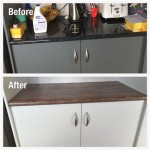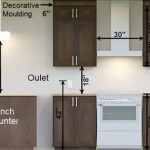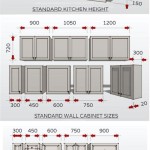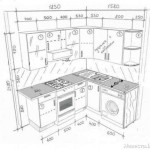How To Manage Kitchen Cabinets Effectively
Kitchen cabinets represent a significant investment in any home. They provide essential storage space and contribute significantly to the overall aesthetic of the kitchen. Effective management of kitchen cabinets involves organization, maintenance, and mindful utilization of space. This facilitates efficient meal preparation, extends the longevity of the cabinets, and maintains an organized and visually appealing kitchen environment. This article delves into key strategies for effectively managing kitchen cabinets.
Optimizing Kitchen Cabinet Organization
Organization is the cornerstone of efficient kitchen cabinet management. A well-organized cabinet system streamlines cooking and cleaning processes. It also minimizes the likelihood of food spoilage and reduces clutter, making the kitchen a more pleasant and functional space.
The initial step is to declutter. Remove all items from the cabinets and assess their relevance. Discard expired food, broken dishes, or utensils that are rarely used. Consider donating items that are in good condition but are no longer needed. This decluttering process provides a clear picture of available space and facilitates the implementation of an effective organization strategy.
Categorizing items is the next crucial stage. Group similar items together, such as baking supplies, canned goods, spices, and cookware. This grouping allows for strategic placement within the cabinets based on frequency of use. Frequently used items should be placed in easily accessible locations, while less frequently used items can be stored in higher or lower cabinets.
Internal organizers are invaluable tools for maximizing cabinet space and improving organization. Shelf dividers help separate stacks of plates or bowls, preventing them from toppling over and making it easier to retrieve individual items. Drawer organizers can be used to neatly arrange silverware, cooking utensils, and other small kitchen gadgets. Lazy Susans are particularly useful for corner cabinets, allowing for easy access to items stored deep within the cabinet.
Vertical storage solutions are also beneficial, especially for storing baking sheets, cutting boards, and platters. Vertical dividers keep these items upright and prevent them from becoming scratched or damaged. They also save space and make it easier to find the specific item needed.
Labeling shelves and containers can further enhance organization. Clear labels help ensure that items are returned to their designated places and make it easy for others to find what they need. Labels can be particularly helpful for pantry items, such as spices, flour, and sugar.
Consider the utilization of door storage. Install spice racks or small shelves on the inside of cabinet doors to create additional storage space for spices, measuring cups, or other small items. This maximizes the use of available space and keeps frequently used items within easy reach.
Finally, maintain the organization regularly. Set aside a few minutes each week to tidy up the cabinets and ensure that items are returned to their proper places. This prevents clutter from accumulating and maintains the efficiency of the organizational system.
Maintaining the Cleanliness and Condition of Kitchen Cabinets
Regular cleaning is essential for maintaining the appearance and extending the lifespan of kitchen cabinets. Grease, spills, and food particles can accumulate on cabinet surfaces over time, leading to discoloration, damage, and potential pest infestations. Proper cleaning techniques and preventative measures are crucial for preserving the integrity of the cabinets.
Establish a regular cleaning schedule. Wipe down cabinet doors and drawers at least once a week with a damp cloth to remove surface dirt and grime. Focus on areas around handles and knobs, which tend to accumulate fingerprints and grease. A mild dish soap solution can be used for more stubborn stains.
When cleaning kitchen cabinets, it is important to use appropriate cleaning products. Avoid harsh chemicals, abrasive cleaners, and scouring pads, as these can damage the finish of the cabinets. Instead, opt for gentle, non-abrasive cleaners specifically designed for kitchen cabinets. Always test the cleaner on an inconspicuous area of the cabinet first to ensure that it does not cause any discoloration or damage.
Pay attention to different cabinet materials. Wood cabinets require special care to prevent moisture damage. Avoid using excessive water when cleaning wood cabinets, and be sure to dry them thoroughly afterwards. Consider using a wood cleaner and polish periodically to maintain the luster of the wood. Laminate cabinets are more resistant to moisture and can be cleaned with a damp cloth and mild detergent. However, avoid using abrasive cleaners, which can scratch the surface.
Address spills and splatters immediately. The longer spills remain on cabinet surfaces, the more difficult they become to remove. Wipe up spills as soon as they occur to prevent staining and damage. Use a soft cloth or sponge to absorb the spill, and then clean the area with a damp cloth and mild detergent.
Protect cabinets from heat and moisture. Avoid placing hot pots and pans directly on cabinet surfaces, as this can cause damage to the finish. Use trivets or hot pads to protect the cabinets from heat. Ensure that the kitchen is properly ventilated to prevent moisture buildup, which can lead to mold and mildew growth. Consider using a dehumidifier in humid climates.
Inspect cabinets regularly for signs of damage, such as scratches, dents, or loose hinges. Repair minor damage promptly to prevent it from worsening. Tighten loose hinges and replace damaged hardware. Consider using touch-up paint or stain to repair scratches and dents. Consult a professional for more extensive repairs.
Consider the use of cabinet liners. Cabinet liners protect the interior surfaces of cabinets from spills, crumbs, and other debris. They also make it easier to clean up messes. Choose liners that are non-adhesive and easy to remove and replace.
Regularly inspect and clean the interiors of cabinets. Remove all items from the cabinets periodically and wipe down the shelves with a damp cloth. This helps to prevent the accumulation of dust, crumbs, and pests. Consider using shelf liners to protect the shelves from spills and stains.
Utilizing Kitchen Cabinet Space Effectively
Optimizing the use of available cabinet space is crucial for maximizing storage capacity and maintaining an organized kitchen. Strategic planning and the implementation of space-saving techniques can significantly increase the efficiency of kitchen cabinets.
Assess available space before purchasing new items. Avoid buying duplicates or items that are not needed. Before going to the grocery store, check the cabinets to see what items are already on hand. This prevents overbuying and reduces clutter.
Maximize vertical space. Utilize the full height of the cabinets by installing adjustable shelves. This allows for customization of storage space based on the size of the items being stored. Use shelf risers or stacking shelves to create additional storage space for dishes, glassware, or canned goods.
Consider pull-out shelves. Pull-out shelves make it easier to access items stored in the back of cabinets. They are particularly useful for deep cabinets, where it can be difficult to reach items at the back. Pull-out shelves can be installed in existing cabinets or incorporated into new kitchen designs.
Utilize corner cabinets effectively. Corner cabinets can be challenging to organize due to their awkward shape. However, there are several solutions that can maximize the use of this space. Lazy Susans are a popular option, providing easy access to items stored in the back of the cabinet. Blind corner pull-outs are another option, allowing for full access to the entire cabinet space.
Consider the use of wall-mounted organizers. Wall-mounted organizers can be used to store pots, pans, and utensils. This frees up cabinet space and keeps frequently used items within easy reach. Choose organizers that are sturdy and can support the weight of the items being stored.
Utilize the space above cabinets. The space above cabinets is often unused but can be valuable storage space. Store infrequently used items, such as holiday decorations or seasonal dishes, in this area. Consider using decorative baskets or bins to store items above the cabinets.
Consider the installation of under-cabinet lighting. Under-cabinet lighting illuminates the countertop and makes it easier to see what is stored in the cabinets. This enhances the functionality of the kitchen and makes it a more pleasant space to work in.
Evaluate the current storage arrangement periodically. As needs change, it may be necessary to re-evaluate the storage arrangement and make adjustments. This ensures that the cabinets continue to be used effectively and efficiently.
By implementing these strategies, homeowners can effectively manage their kitchen cabinets, creating an organized, functional, and visually appealing kitchen space. Effective cabinet management contributes to a more efficient cooking experience and extends the lifespan of the cabinets themselves.

60 Clever Cabinet Organization Tips To Double Your Storage 2024

60 Clever Cabinet Organization Tips To Double Your Storage 2024

How To Organize Kitchen Cabinets In 9 Simple Steps Trusted Since 1922

How To Organize Your Kitchen Make It More Functional

How To Organize Kitchen Cabinets In 9 Simple Steps Trusted Since 1922

Corner Kitchen Cabinet Ideas For Proper Storage Choice

12 Small Kitchen Organization Ideas Simply Quinoa

12 Small Kitchen Organization Ideas Simply Quinoa

30 Kitchen Cabinet Add Ons You Can Diy Family Handyman
:max_bytes(150000):strip_icc()/crop-silvery-blue-cabinets-2000-70acba9f5faf464aa377714297d92570-a9692c7ba11e44ac86bc8f41c0a9fb42.jpg?strip=all)
How To Organize Your Kitchen Cabinets According Experts
Related Posts








